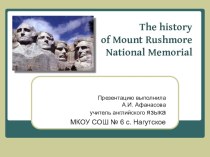- Главная
- Разное
- Бизнес и предпринимательство
- Образование
- Развлечения
- Государство
- Спорт
- Графика
- Культурология
- Еда и кулинария
- Лингвистика
- Религиоведение
- Черчение
- Физкультура
- ИЗО
- Психология
- Социология
- Английский язык
- Астрономия
- Алгебра
- Биология
- География
- Геометрия
- Детские презентации
- Информатика
- История
- Литература
- Маркетинг
- Математика
- Медицина
- Менеджмент
- Музыка
- МХК
- Немецкий язык
- ОБЖ
- Обществознание
- Окружающий мир
- Педагогика
- Русский язык
- Технология
- Физика
- Философия
- Химия
- Шаблоны, картинки для презентаций
- Экология
- Экономика
- Юриспруденция
Что такое findslide.org?
FindSlide.org - это сайт презентаций, докладов, шаблонов в формате PowerPoint.
Обратная связь
Email: Нажмите что бы посмотреть
Презентация на тему Russian painting in the second half XIX - beginning of XX century
Содержание
- 2. Ivan AivazovskyThe Ninth Wave. 1850. Oil on
- 3. Ivan AivazovskyBrig "Mercury" Attacked by Two Turkish
- 4. Ivan Shishkin"Morning in a pine forest“1886. Oil
- 5. Ivan Shishkin“Rye Fields”1878. Oil on canvas. Tretyakov Gallery, Moscow
- 6. Arkhip Kuindzhi"Dnepr in the morning“1881. Oil on
- 7. Arkhip Kuindzhi"Mount Elbrus, moonlit night “1890-1895. Oil on paper mounted on canvas. Tretyakov Gallery, Moscow
- 8. Isaac Levitan"Lake“1900. Oil on canvas "Lake"
- 9. Isaac Levitan"Lake“1900. Oil on canvas “Autumn Landscape” 1880“Sunny Day” 1876
- 10. Alexei K. Savrasov“The rooks have returned”1871. Oil
- 11. Alexei K. Savrasov“View of the Kremlin from
- 12. Fyodor Vasilyev"Wet Meadow“1872. Oil on canvas. The
- 13. Fyodor Vasilyev“After a Heavy Rain” 1870
- 14. Mikhail VrubelLilac (Siren). 1900. Oil on canvas.
- 15. Скачать презентацию
- 16. Похожие презентации
Ivan AivazovskyThe Ninth Wave. 1850. Oil on canvas. The State Russian Museum, St. Petersburg, Russia. "The ninth wave" is a true masterwork. Aivazovsky reaches in this painting an absolute technical perfection, representing a group of

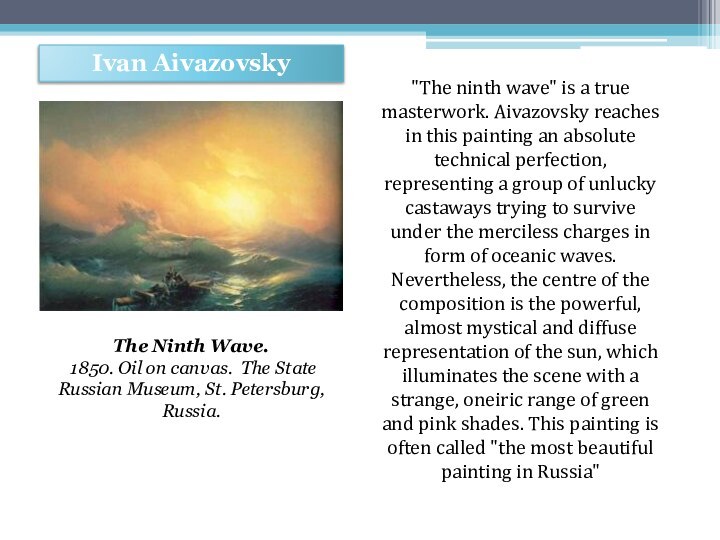


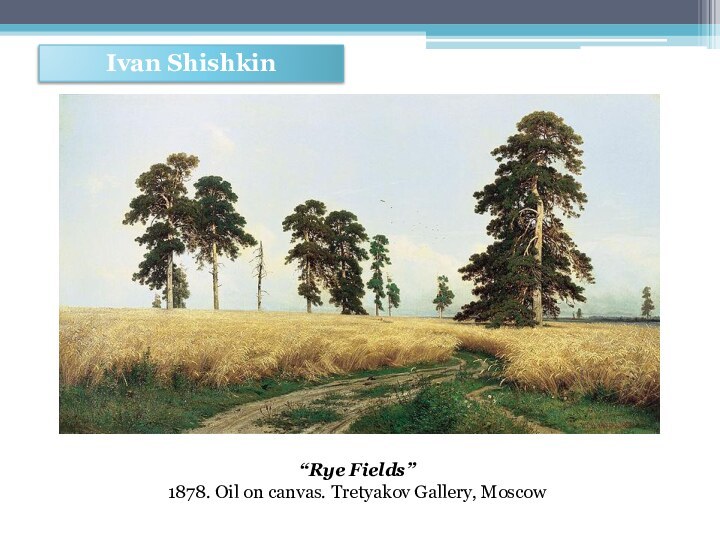


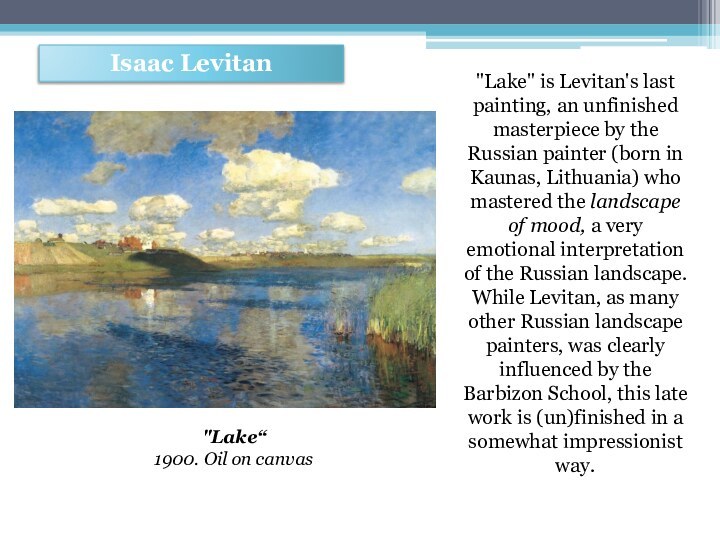

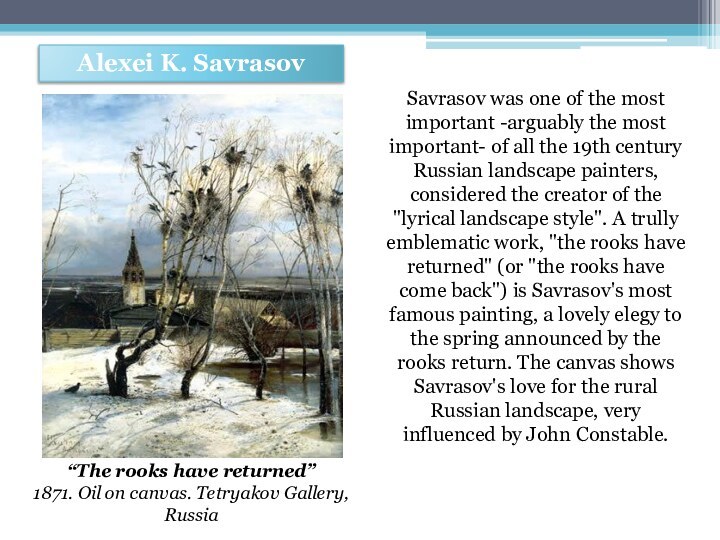





Слайд 2
Ivan Aivazovsky
The Ninth Wave.
1850. Oil on
canvas. The State Russian Museum, St. Petersburg, Russia.
ninth wave" is a true masterwork. Aivazovsky reaches in this painting an absolute technical perfection, representing a group of unlucky castaways trying to survive under the merciless charges in form of oceanic waves. Nevertheless, the centre of the composition is the powerful, almost mystical and diffuse representation of the sun, which illuminates the scene with a strange, oneiric range of green and pink shades. This painting is often called "the most beautiful painting in Russia"
Слайд 3
Ivan Aivazovsky
Brig "Mercury" Attacked by Two Turkish Ships
1892.
Oil on canvas. The Tretyakov Gallery, Moscow, Russia
Слайд 4
Ivan Shishkin
"Morning in a pine forest“
1886. Oil on
canvas. Tetryakov Gallery, Russia
"Morning in a pine forest" is
a marvelous pictorial fantasy that goes beyong the pure realism developed by many other Russian painters of the era. Shishkin has chosen one of his favorite motifs, the dense Russian pine forest, adding the unusual and rather bucolic presence of a family of bears.
Слайд 6
Arkhip Kuindzhi
"Dnepr in the morning“
1881. Oil on canvas.
The Tretyakov Gallery, Moscow, Russia
"Dnepr in the morning" (as
"Dnepr in the night", executed a year before) is considered as one of the first works finished with Kuindshi's "mature" style, with stunning light and atmospheric effects. This panoramic view is especially remarkable for its simple but very strong composition.
Слайд 7
Arkhip Kuindzhi
"Mount Elbrus, moonlit night “
1890-1895. Oil on paper
mounted on canvas. Tretyakov Gallery, Moscow
Слайд 8
Isaac Levitan
"Lake“
1900. Oil on canvas
"Lake" is Levitan's last
painting, an unfinished masterpiece by the Russian painter (born
in Kaunas, Lithuania) who mastered the landscape of mood, a very emotional interpretation of the Russian landscape.While Levitan, as many other Russian landscape painters, was clearly influenced by the Barbizon School, this late work is (un)finished in a somewhat impressionist way.
Слайд 10
Alexei K. Savrasov
“The rooks have returned”
1871. Oil on
canvas. Tetryakov Gallery, Russia
Savrasov was one of the most
important -arguably the most important- of all the 19th century Russian landscape painters, considered the creator of the "lyrical landscape style". A trully emblematic work, "the rooks have returned" (or "the rooks have come back") is Savrasov's most famous painting, a lovely elegy to the spring announced by the rooks return. The canvas shows Savrasov's love for the rural Russian landscape, very influenced by John Constable.
Слайд 12
Fyodor Vasilyev
"Wet Meadow“
1872. Oil on canvas. The Tretyakov
Gallery, Moscow, Russia
Feodor Vasilyev was a brillian "boy genius"
who established himself as one of the most important and respected Russian painters of his era, introducing the lyrical landscape style in Russian painting. "Wet meadow" is a beautiful, lyric masterwork done completely from memory and a few sketches of the Russian plains.
Слайд 14
Mikhail Vrubel
Lilac (Siren).
1900. Oil on canvas. The Tretyakov
Gallery, Moscow, Russia.
In 1900, Vrubel became member of the
World of Art group. The same year, he produced some of his best canvases, including The Swan Princess and Lilac. The artist's fervent love of nature helped him to convey its beauty. The luxuriant clusters of lilac in the painting "Lilac" are alive and fragrant in the starlit night. One of Vrubel's contemporaries wrote that nature blinded him (the artist did indeed go blind near the end of his life) because he looked too closely at its secrets.









